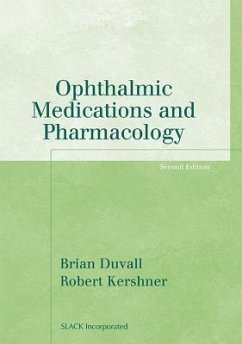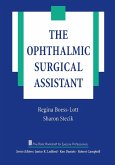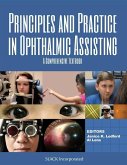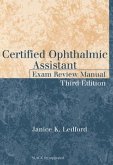- Broschiertes Buch
- Merkliste
- Auf die Merkliste
- Bewerten Bewerten
- Teilen
- Produkt teilen
- Produkterinnerung
- Produkterinnerung
For those who are new to the subject, ocular pharmacology can be a difficult and sometimes overwhelming topic.Ophthalmic Medications and Pharmacology, Second Edition is a reader-friendly guide that provides a quick review and basic clinical reference of ocular pharmacology.
Andere Kunden interessierten sich auch für
![The Ophthalmic Surgical Assistant The Ophthalmic Surgical Assistant]() Regina Boess-LottThe Ophthalmic Surgical Assistant88,99 €
Regina Boess-LottThe Ophthalmic Surgical Assistant88,99 €![Principles and Practice in Ophthalmic Assisting Principles and Practice in Ophthalmic Assisting]() Janice K LedfordPrinciples and Practice in Ophthalmic Assisting132,99 €
Janice K LedfordPrinciples and Practice in Ophthalmic Assisting132,99 €![Certified Ophthalmic Assistant Exam Review Manual Certified Ophthalmic Assistant Exam Review Manual]() Janice K. LedfordCertified Ophthalmic Assistant Exam Review Manual93,99 €
Janice K. LedfordCertified Ophthalmic Assistant Exam Review Manual93,99 €![Ophthalmic Plastic Surgery Ophthalmic Plastic Surgery]() Suzanne FreitagOphthalmic Plastic Surgery135,99 €
Suzanne FreitagOphthalmic Plastic Surgery135,99 €![Clinical Ophthalmic Echography Clinical Ophthalmic Echography]() Roger P. HarrieClinical Ophthalmic Echography94,99 €
Roger P. HarrieClinical Ophthalmic Echography94,99 €![Contact Lenses in Ophthalmic Practice Contact Lenses in Ophthalmic Practice]() Mark J. MannisContact Lenses in Ophthalmic Practice79,99 €
Mark J. MannisContact Lenses in Ophthalmic Practice79,99 €![Extemporaneous Ophthalmic Preparations Extemporaneous Ophthalmic Preparations]() Eman Ali Saeed AlghamdiExtemporaneous Ophthalmic Preparations44,99 €
Eman Ali Saeed AlghamdiExtemporaneous Ophthalmic Preparations44,99 €-
-
-
For those who are new to the subject, ocular pharmacology can be a difficult and sometimes overwhelming topic.Ophthalmic Medications and Pharmacology, Second Edition is a reader-friendly guide that provides a quick review and basic clinical reference of ocular pharmacology.
Hinweis: Dieser Artikel kann nur an eine deutsche Lieferadresse ausgeliefert werden.
Hinweis: Dieser Artikel kann nur an eine deutsche Lieferadresse ausgeliefert werden.
Produktdetails
- Produktdetails
- Verlag: CRC Press
- 2. Auflage
- Seitenzahl: 146
- Erscheinungstermin: 1. Oktober 2006
- Englisch
- Abmessung: 254mm x 178mm x 8mm
- Gewicht: 289g
- ISBN-13: 9781556427503
- ISBN-10: 1556427506
- Artikelnr.: 21286535
- Herstellerkennzeichnung
- Libri GmbH
- Europaallee 1
- 36244 Bad Hersfeld
- gpsr@libri.de
- Verlag: CRC Press
- 2. Auflage
- Seitenzahl: 146
- Erscheinungstermin: 1. Oktober 2006
- Englisch
- Abmessung: 254mm x 178mm x 8mm
- Gewicht: 289g
- ISBN-13: 9781556427503
- ISBN-10: 1556427506
- Artikelnr.: 21286535
- Herstellerkennzeichnung
- Libri GmbH
- Europaallee 1
- 36244 Bad Hersfeld
- gpsr@libri.de
Brian S. Duvall, OD, pursued his undergraduate studies at Central Washington University and his Doctor of Optometry from Pacific University College of Optometry, graduating with distinction. Dr. Duvall then completed fellowship training in the treatment and management of ocular disease at Omni Eye Specialist in Denver, Colo. Following his residency training, Dr. Duvall served in Tucson, Ariz as the Director of Optometric Consultative services at The Orange Grove Center for Corrective Eye Surgery. With the emergence of excimer laser technology, Dr. Duvall joined TLC Laser Eye Centers as an Executive and Clinical Director in both Indianapolis and Seattle, serving as a consultant, clinician, and educator. Dr. Duvall currently serves as director at Snoqualmie Valley Eyecare, a private group practice in the Cascade gateway, east of Seattle, Wash. Aside from his clinical and administrative duties, Dr. Duvall maintains his role as an educator and consultant within the optometric community; he lectures and publishes frequently on many aspects of medical and surgical eyecare and has served as co-host with Dr. Kershner on television's "Eye on Health." Dr. Duvall has volunteered his time and resources on eyecare mission trips, has served at many levels in his local and state organizations, and is an adjunct Professor to Pacific University College of Optometry. Dr. Duvall has received the highest accolades from faculty, students, patients, and colleagues as an accomplished educator and clinician. Robert M. Kershner, MD, MS, FACS, pursued his undergraduate studies in Molecular Biology at Boston University, graduated with honors, and received the Distinguished Alumni Award in 2002. He received his Masters of Science in Cell Biology and Biochemistry and Doctor of Medicine degrees with honors at the University of Vermont College of Medicine. He completed his Internship in General Surgery and his specialty training in Ophthalmology at the University of Arizona Health Sciences Center in Tucson, and was chief resident in Ophthalmology at the University of Utah Medical Center in Salt Lake City, Utah. He is certified by the American Board of Ophthalmology, subspecialty certified in Cataract and Refractive Surgery by the American Board of Eye Surgery, a Fellow of the American Academy of Ophthalmology, a Fellow of the American Society of Cataract and Refractive Surgery, and a Fellow of the American College of Surgeons. Dr. Kershner is President and CEO of Eye Laser Consulting, Boston, Mass; Clinical Professor of Ophthalmology at the John A. Moran Eye Center, University of Utah School of Medicine in Salt Lake City, Utah; IK Ho Visiting Professor of Ophthalmology at the Chinese University of Hong Kong; Past Chief of the Section of Ophthalmology and nominated for Chief of Staff at Northwest Medical Center, Tucson, Ariz; Past Medical Director-Pima Medical Institute; Board Member, American College of Eye Surgeons; Past Chairman of the Anterior Segment Fellowship Program; and Founder and Director Emeritus of the Eye Laser Center in Tucson, Ariz. Dr. Kershner has authored over 200 scientific articles, contributed to 20 textbooks, and is on the editorial board of numerous scientific journals. He has been featured on radio, in print (in USA Today and Newsweek, performing surgery with the Implantable Miniature Telescope), and on television (on CNN and ABC's Evening News Tonight with Peter Jennings, as well as hosting the popular weekly cable television series "Eye on Health"). Dr. Kershner has been active in research to develop new intraocular lens implants, is a pioneer in the development of new microsurgical techniques (for cataract, refractive, and glaucoma surgery), and has developed numerous medical devices and surgical instruments that bear his name. In addition to teaching other ophthalmologists and industry representatives in the United States, Dr. Kershner has been an invited speaker in Austria, Brazil, France, Italy, Norway, India, Canada, Mexico, China, Switzerland, Thailand, Taiwan, Japan, South Africa, Holland, Australia, Czech Republic, and Russia. He has been honored for his teaching and surgical skills by the International Association for Training and Research in Ophthalmic Surgery in Stansstad, Switzerland; by the late Director General and Professor Svyatoslav N. Fyodorov of the Intersectoral Research and Technology Complex in Moscow, Russia; and by the Japanese Society for Cataract Research, the Japan Intraocular Lens Implant Society. He is the recipient of the Alcon Surgical Award for Achievement in Ophthalmology, the Achievement Award of the American Academy of Ophthalmology, the gold medal from the Indian Intraocular Implant and Refractive Society (the Maharshtra Ophthalmic Society, the Bombay Ophthalmologist's Association), and received the IK HO Visiting Professorship of Ophthalmology from the Chinese University of Hong Kong. In 1994, Dr. Kershner received the Republican Senatorial Medal of Freedom, the highest honor the Republican members of the United States Senate can bestow on a private citizen. Dr. Kershner was listed in the 2002-2003 Guide to America's Top Ophthalmologists published by the Consumers' Research Council of America in Washington, DC. He received a National Leadership Award given by Dennis Hastert, Speaker of the House, on behalf of the United States Congress in 2002. He was inducted into the Collegium of Distinguished Alumni of the College of Arts and Sciences at Boston University in May 2002.
Contents Dedication iii Acknowledgments vii About the Author ix
Introduction xi The Study Icons xiii Chapter 1. Pharmaceutical
Characteristics and Delivery 1 Chapter 2. Clinical Administration 7 Chapter
3. The Autonomic Nervous System 15 Chapter 4. Diagnostic Pharmaceuticals 21
Chapter 5. Use of Ocular Lubricants, Cyclosporine, and Osmotics 33 Chapter
6. Vasoconstrictors, Antihistamines, and Mast Cell Stabilizers 45 Chapter
7. The Corticosteroids 53 Chapter 8. Nonsteroidal Anti-Inflammatory Drugs
(NSAIDs) 63 Chapter 9. Anesthetics 69 Chapter 10. Anti-Infectives 75
Chapter 11. Antiglaucoma Agents 89 Chapter 12. Side Effects, Toxicity, and
Hypersensitivity 103 Chapter 13. Retinal Therapies 109 Appendix A: Acute
Drug Reactions and Emergencies 113 Appendix B: Vitamins 117 Appendix C: The
Drug Approval Process 123 Index &
Introduction xi The Study Icons xiii Chapter 1. Pharmaceutical
Characteristics and Delivery 1 Chapter 2. Clinical Administration 7 Chapter
3. The Autonomic Nervous System 15 Chapter 4. Diagnostic Pharmaceuticals 21
Chapter 5. Use of Ocular Lubricants, Cyclosporine, and Osmotics 33 Chapter
6. Vasoconstrictors, Antihistamines, and Mast Cell Stabilizers 45 Chapter
7. The Corticosteroids 53 Chapter 8. Nonsteroidal Anti-Inflammatory Drugs
(NSAIDs) 63 Chapter 9. Anesthetics 69 Chapter 10. Anti-Infectives 75
Chapter 11. Antiglaucoma Agents 89 Chapter 12. Side Effects, Toxicity, and
Hypersensitivity 103 Chapter 13. Retinal Therapies 109 Appendix A: Acute
Drug Reactions and Emergencies 113 Appendix B: Vitamins 117 Appendix C: The
Drug Approval Process 123 Index &
Contents Dedication iii Acknowledgments vii About the Author ix
Introduction xi The Study Icons xiii Chapter 1. Pharmaceutical
Characteristics and Delivery 1 Chapter 2. Clinical Administration 7 Chapter
3. The Autonomic Nervous System 15 Chapter 4. Diagnostic Pharmaceuticals 21
Chapter 5. Use of Ocular Lubricants, Cyclosporine, and Osmotics 33 Chapter
6. Vasoconstrictors, Antihistamines, and Mast Cell Stabilizers 45 Chapter
7. The Corticosteroids 53 Chapter 8. Nonsteroidal Anti-Inflammatory Drugs
(NSAIDs) 63 Chapter 9. Anesthetics 69 Chapter 10. Anti-Infectives 75
Chapter 11. Antiglaucoma Agents 89 Chapter 12. Side Effects, Toxicity, and
Hypersensitivity 103 Chapter 13. Retinal Therapies 109 Appendix A: Acute
Drug Reactions and Emergencies 113 Appendix B: Vitamins 117 Appendix C: The
Drug Approval Process 123 Index &
Introduction xi The Study Icons xiii Chapter 1. Pharmaceutical
Characteristics and Delivery 1 Chapter 2. Clinical Administration 7 Chapter
3. The Autonomic Nervous System 15 Chapter 4. Diagnostic Pharmaceuticals 21
Chapter 5. Use of Ocular Lubricants, Cyclosporine, and Osmotics 33 Chapter
6. Vasoconstrictors, Antihistamines, and Mast Cell Stabilizers 45 Chapter
7. The Corticosteroids 53 Chapter 8. Nonsteroidal Anti-Inflammatory Drugs
(NSAIDs) 63 Chapter 9. Anesthetics 69 Chapter 10. Anti-Infectives 75
Chapter 11. Antiglaucoma Agents 89 Chapter 12. Side Effects, Toxicity, and
Hypersensitivity 103 Chapter 13. Retinal Therapies 109 Appendix A: Acute
Drug Reactions and Emergencies 113 Appendix B: Vitamins 117 Appendix C: The
Drug Approval Process 123 Index &








